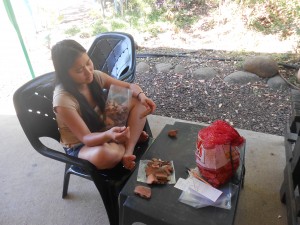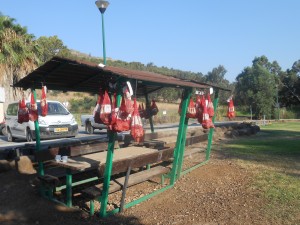In my time working here I have found that pottery punctuates the workday at Omrit with more regularity than any other aspect of the excavation. In my square, we routinely commence the day’s work by filling out our pottery tag for our open locus. Throughout the morning we collect the pottery sherds from that locus and save them in a particular bucket, and this pottery bucket makes its way back to the kibbutz with us when we leave the field at 11:30am. Occasionally the bumpy ride back to Kfar Szold puts the pottery bucket in jeopardy of spilling, but when an unexpected dip in the road sends people and buckets careening into the air, we (like the true, selfless archaeologists that we are) instinctively reach out to protect our pottery buckets, sometimes at the expense of an elbow or a knee.
Once we return to the kibbutz, pottery buckets from previous days await us and our scrubbing brushes! We must wash all of our pottery sherds so that Omrit’s ceramicist is able to analyze them later in the week. The wet pottery is then placed in bags and hung out to dry. After my squaremates and I have washed our pottery for the day, we grab the dry pottery and organize them into two sets: indicative sherds and nonindicative sherds. The former category consists of the rims of vessels, sherds with glazes, and sherds bearing designs. Nonindicative sherds are all of the remaining pottery sherds, usually from the bodies of vessels.
At the end of a week of excavation, we assemble our processed pottery and show the indicative sherds to our ceramicist, who is able to use them to determine the dating of our loci. At these weekly pottery readings I have learned to distinguish the rim of a Byzantine cooking pot from the rim of a Byzantine storage vessel, recognize the striking red gloss of Roman fine ware and the exquisite green glaze of pottery from the Crusader period, and visualize the form of a vessel from a single fragment of its body. Pottery analysis is crucial to our understanding of our squares, and it is especially important since the focus of the excavation at Omrit has shifted from the temple itself to the area northwest of the temple—an area that appears to have been primarily domestic and industrial space, necessitating an increased dependency on the analysis of material culture such as pottery.
For some, the fact that pottery is so commonplace at the site and so fundamental to the way we structure our time working at Omrit turns it into a bit of a chore, but I have always found pottery to be one of my favorite aspects of the excavation. The study of pottery also reflects a larger approach to the study of the past, and I find this relevant to my own major in modern history at Williams; I draw a parallel between the archaeological study of monumental structures like temples, palaces, and fortresses and the historical study of great men and decisive events, as well as a parallel between the archaeological focus on material culture like pottery and the incorporation of the “everyday” person into the field of historical study. In this way Omrit encompasses a diverse set of methodologies and approaches that keep me engaged on many levels, and pottery has been a very tangible way for me to try and piece together the story of Omrit.


